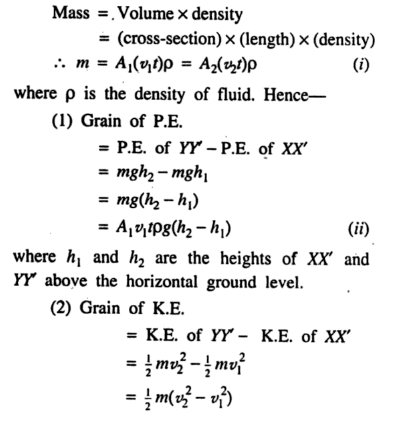Table of Contents
Energy Possessed By a Liquid:
A liquid element in motion possesses the following three kinds of energy-
(1) Kinetic Energy- A liquid element of mass m moving with a velocity ν has a kinetic energy (1/2) mν2. If we take into account only a unit volume (m = ρ) where ρ is density, we have
| Kinetic energy = (1/2) ρν2 |
(2) Potential Energy- Let the liquid element of mass m be at height h above the ground. It then possesses a potential energy mgh. If we consider only a unit volume (m = ρ), then
| Potential energy = ρgh |
(3) Pressure Energy- Imagine that a liquid element of mass m at the surface of a liquid is brought down by a vertical height x. Then it loses its potential energy by mgx. Where does this energy go? We find that the liquid element has now a hydrostatic pressure p = xρg where ρ is the density of the liquid. We, therefore, say that when a liquid element of mass m is brought down by a height x, it loses potential energy mgx which appears as pressure energy. Thus the pressure energy is given by mgx, and in terms of pressure p (= xρg) it is given by mp/ρ i.e. pV as m/ρ = V where V is the volume of an element of mass m.
Hence for a unit volume, Pressure energy = P
Taking into account all three types of energy possessed by the liquid in motion, we find that the total energy of a unit volume of the liquid is given by
| E = (1/2) ρν2 + ρgh + p |
If the liquid is non-viscous i.e., if there is no internal friction present the energy possessed per unit volume at one location should be equal to that possessed at any other location. Thus, if subscripts 1 and 2 refer to any two locations, we have

Bernoulli’s theorem states that when an ideal fluid (non-compressible and non-viscous) flows in a streamlined motion from one point to another, then at every point of its path the total energy per unit volume (i.e., kinetic energy + potential energy + pressure energy) remains constant.
In fact, Bernoulli’s theorem is a statement of the law of conservation of energy as applied to a fluid in motion.
Bernoulli’s Theorem in terms of Various Heads:
Bernoulli’s theorem can be written in the following form:
| ν2/2g + h + p/ρg = constant |
Here ν2/2g, p/ρg and h have the same dimensions. The quantity ν2/2g is, therefore, known as the velocity head, h is called the gravitational head, and p/ρg is the pressure head. Therefore, we can restate Bernoulli’s theorem as follows:
In a streamlined motion of an ideal fluid, the sum of the velocity head, gravitational head, and pressure head is constant.
Formal Derivation:

Consider a fluid flowing through a non-uniform tube XY. Suppose its velocity changes from ν1 at X where the cross-section is A1 to ν2 where the cross-section is A2. Let us apply the law of conservation of energy to a small element of liquid XX’ that enters at the left in a time t and leaves as YY’ to the right. If the mass of the liquid element, under consideration is m then,












Comments (No)